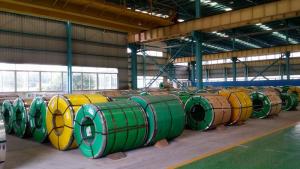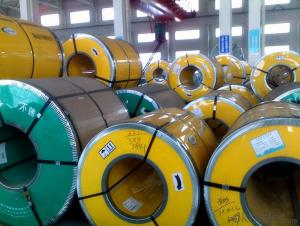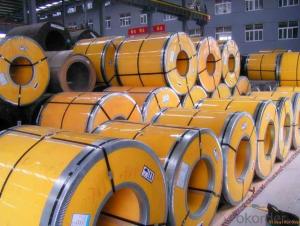Cold Rolled Stainless Steel Coil 304 Grade BA Finish
- Loading Port:
- China Main Port
- Payment Terms:
- TT OR LC
- Min Order Qty:
- -
- Supply Capability:
- -
OKorder Service Pledge
OKorder Financial Service
You Might Also Like
Cold Rolled Stainless Steel Coil 304 Grade BA Finish
Packaging Detail:standard export packing or as customer's requirements
Delivery Detail:7-15 days after the order
MOQ: 25mt
Standard: | AISI,ASTM,BS,DIN,GB,JIS | Grade: | 304 | Thickness: | 0.3-3.0mm |
Place of Origin: | China Mainland | Brand Name: | CNBM | Model Number: | 304 |
Type: | Steel Coil | Technique: | Cold Rolled | Surface Treatment: | 2B, BA |
Application: | Medical instruments, building, chemical food industry agriculture | Width: | 500-2000mm | Length: | Coil |
finish: | BA | item: | 304 cold rolled stainless steel coil | density: | 7.93 |
Cold Rolled Stainless Steel Coil 304 Grade BA Finish
Chemical composition: |
| ||||||
C | Si | Mn | Cr | Ni | S | P | |
≤0.07 | ≤1.0 | ≤2.0 | 18.0~20.0 | 8.0~11.0 | ≤0.03 | ≤0.035 | |
mechanical properties: |
| ||||||
Tensile strength σb (MPa) | Conditions yield strength 0.2 sigma (MPa) | Elongation δ5 (%) | Section shrinkage (%) | Hardness | |||
520 | 205 | 40 | 60 | ≤1 | |||
- Q:Can stainless steel strips be used for knife blades?
- Yes, stainless steel strips can be used for knife blades. Stainless steel is a popular choice for knife blades due to its corrosion resistance, durability, and ease of maintenance. Stainless steel strips provide a versatile and cost-effective option for manufacturing knife blades. However, it is important to note that the specific type of stainless steel used and its heat treatment process will greatly affect the blade's performance. Higher quality stainless steel strips with the appropriate hardness and edge retention properties are typically preferred for knife blades.
- Q:What are the different packaging options for stainless steel strips?
- Stainless steel strips have various packaging options available to cater to the specific requirements and preferences of customers: 1. Coils: Coils are tightly wound stainless steel strips that are secured with straps or plastic wrap. They offer easy handling, transportation, and storage, making them efficient for large quantities. 2. Wooden Crates: For enhanced protection and durability, stainless steel strips can be packed neatly in wooden crates. Straps or foam inserts are used to secure the strips, preventing damage during shipping or storage. Wooden crates are commonly used for heavy-duty applications or long-term storage. 3. Pallets: Stainless steel strips can also be packaged on pallets, where they are stacked and secured with bands or shrink wrap. This option allows for convenient handling using forklifts and ensures stability during transportation. Pallets are suitable for smaller quantities of strips. 4. Bundles: Bundling stainless steel strips together using plastic or steel bands keeps them organized and secure, preventing tangling or damage. Bundles are ideal for smaller quantities, offering easy handling and storage. 5. Custom Packaging: Custom options for packaging stainless steel strips can be tailored to specific customer needs. This may involve adding protective covers, foam inserts, or custom labeling for easy identification. Custom packaging ensures adequate protection and readiness for use upon delivery. In conclusion, the packaging options for stainless steel strips vary depending on factors such as quantity, transportation requirements, and desired level of protection. Manufacturers and suppliers collaborate closely with customers to determine the most suitable packaging option, ensuring the safe and efficient delivery of stainless steel strips.
- Q:Can stainless steel strips be used in food processing industries?
- Stainless steel strips find their application in the food processing industries. They are widely utilized due to their hygienic properties, resistance to corrosion, and long-lasting nature. Various uses of stainless steel strips include conveyor belts, food-grade equipment, storage tanks, and processing machinery. The smooth and non-porous surface of stainless steel facilitates effortless cleaning and maintenance, thereby preventing bacterial growth and ensuring food safety. Moreover, stainless steel exhibits resistance against chemicals and high temperatures, making it ideal for critical sanitization and sanitation requirements in food processing environments.
- Q:Can stainless steel strips be used in the production of HVAC grilles?
- Yes, stainless steel strips can be used in the production of HVAC grilles. Stainless steel is a popular material choice for HVAC grilles due to its durability, corrosion resistance, and aesthetic appeal. The use of stainless steel strips in the production of HVAC grilles ensures that the grilles will be able to withstand the harsh conditions of heating, ventilation, and air conditioning systems without rusting or deteriorating over time. Additionally, stainless steel strips offer a sleek and modern appearance, making them an ideal choice for architectural and design purposes. Overall, stainless steel strips are a suitable and reliable option for manufacturing HVAC grilles.
- Q:What are the different types of stainless steel strip edges?
- There are several types of stainless steel strip edges, including mill edge, slit edge, round edge, deburred edge, and square edge. Each type has a specific purpose and provides a different level of finish and functionality for various applications.
- Q:Can stainless steel strips be used in the oil and gas industry?
- Yes, stainless steel strips can be used in the oil and gas industry. Stainless steel is known for its corrosion resistance, high strength, and durability, making it ideal for various applications in this industry, including pipelines, storage tanks, and offshore structures. It is capable of withstanding harsh environments and is resistant to corrosion caused by exposure to oil, gas, and other chemicals, making it a reliable material choice in the oil and gas sector.
- Q:Can stainless steel strips be used in automotive applications?
- Certainly, automotive applications readily benefit from the use of stainless steel strips. Renowned for its exceptional corrosion resistance, durability, and strength, stainless steel emerges as the ideal substance for a wide array of automotive components. Exhaust systems, fuel tanks, body panels, trim, and even structural elements frequently employ this material during their manufacturing process. Stainless steel strips can be shaped, welded, and fabricated into diverse sizes and forms, offering automotive design with unparalleled versatility and flexibility. Moreover, the aesthetic charm and long-lasting visual appeal that stainless steel preserves over time contribute to its widespread popularity among automotive applications.
- Q:Can stainless steel strips be cold rolled?
- Indeed, cold rolling is feasible for stainless steel strips. During this procedure, the stainless steel strip undergoes passage through a series of rollers at ambient temperature, resulting in a reduction in thickness and an enhancement of its surface finish. Cold rolling finds frequent application in the manufacturing of stainless steel strips due to its capability to bolster their strength, hardness, and dimensional precision. Furthermore, this versatile process enables the formation of stainless steel strips in varied shapes and sizes, thereby contributing to its significance in the stainless steel industry.
- Q:How do stainless steel strips perform in acidic environments?
- In acidic environments, stainless steel strips possess a high resistance to corrosion, making them an ideal material for usage. The inclusion of chromium in stainless steel results in the creation of a protective layer, known as a passive film, on its surface. This passive film functions as a barrier, shielding the underlying steel from the damaging effects of the acid. Furthermore, stainless steel also contains other alloying elements like nickel and molybdenum, further bolstering its ability to withstand corrosion in acidic environments. As a result, stainless steel strips display remarkable durability and performance when exposed to acidic conditions, rendering them the preferred choice in a wide range of applications including chemical processing, food processing, and marine environments.
- Q:Can stainless steel strips be used in the power generation industry?
- Yes, stainless steel strips can be used in the power generation industry. Stainless steel is known for its durability, corrosion resistance, and high strength-to-weight ratio, making it a suitable material for various applications in the power generation industry. Stainless steel strips can be used in the construction of power plants, particularly in components such as heat exchangers, boilers, and condensers. These components require materials that can withstand high temperatures, pressure, and corrosive environments, which stainless steel can provide. Furthermore, stainless steel strips can be used in the production of turbine blades and other critical parts of turbines. These components need to withstand extreme conditions, such as high temperatures and rotational forces, and stainless steel's mechanical properties make it a reliable choice for such applications. In addition, stainless steel strips can be used in the manufacturing of electrical equipment and power transmission systems. Stainless steel's electrical conductivity and resistance to corrosion make it suitable for electrical connectors, bus bars, and other components that are crucial for power generation and transmission. Overall, stainless steel strips have proven to be a valuable material in the power generation industry due to their exceptional properties and performance.
1. Manufacturer Overview |
|
|---|---|
| Location | |
| Year Established | |
| Annual Output Value | |
| Main Markets | |
| Company Certifications | |
2. Manufacturer Certificates |
|
|---|---|
| a) Certification Name | |
| Range | |
| Reference | |
| Validity Period | |
3. Manufacturer Capability |
|
|---|---|
| a)Trade Capacity | |
| Nearest Port | |
| Export Percentage | |
| No.of Employees in Trade Department | |
| Language Spoken: | |
| b)Factory Information | |
| Factory Size: | |
| No. of Production Lines | |
| Contract Manufacturing | |
| Product Price Range | |
Send your message to us
Cold Rolled Stainless Steel Coil 304 Grade BA Finish
- Loading Port:
- China Main Port
- Payment Terms:
- TT OR LC
- Min Order Qty:
- -
- Supply Capability:
- -
OKorder Service Pledge
OKorder Financial Service
Similar products
New products
Hot products
Related keywords































